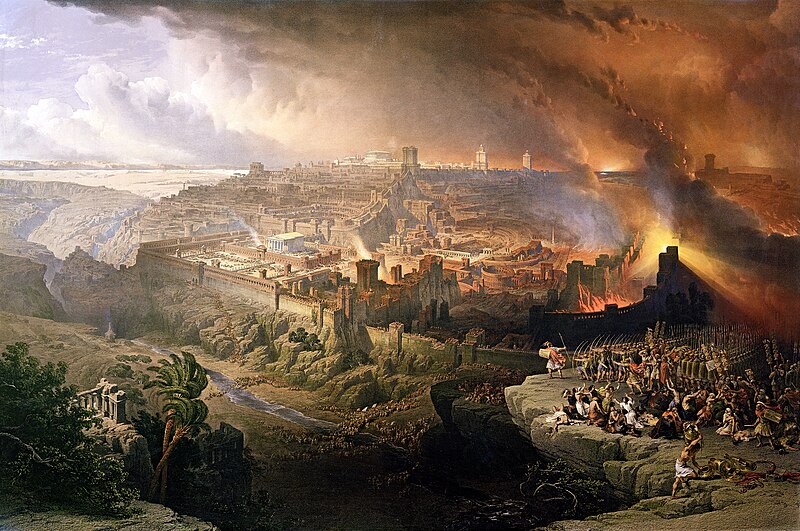The Mobility of Yahweh
In August of 586, Jerusalem was overtaken by the Babylonians, and the city along with its precious First Temple was destroyed and burned down. This Temple was built according to Yahweh’s instructions and was considered to be his home on earth, so the burning down of this sacred home to many seems like a symbol that Yahweh had failed to protect his city and was proven to not be as powerful or protective as many had formerly believed.
Because Jerusalem was no longer in a shape that could allow humanity to survive and prosper, the people were forced out and many found themselves in areas of Babylon. It was to their shock that the exiles from Jerusalem found themselves living in important districts and capable of quickly prospering in their new home with the same people who had burned down their home and the home of their God. Although in a new land, these people still tried to turn to the same Yahweh, but they quickly ran into a problem with this.
In the present day, people believe in the effectiveness of prayer as a way to communicate with their God whenever and wherever they are, but in the 1st century, the Judeans believed that they could only communicate with Yahweh effectively after being forced out of Jerusalem because “according to the Deuteronomist ideal there was only one legitimate shrine for Israel and that was in Jerusalem” (Armstrong, page 83). Without physically being in what they believed to be the presence of Yahweh, it is likely that many of these exiles felt very lost when they first got to Babylon. I would not even blame them for feeling angry at their God or unsure of his power because everything that they had believed in was taken from them suddenly and in a way with no positive end in sight.
A revelation by the exiled priest by the name of Ezekiel turned everything the exiles thought they had lost around, as Ezekiel saw a vision of Yahweh in his home in Babylon, proving for the first time that Yahweh was not confined to the limits of his “home on earth,” being the temple in Jerusalem, but that he would travel to be with his people. As Armstrong put it, “He was not confined to either the Temple or the Promised Land, like so many of the pagan gods” (Armstrong, page 84). The Yahweh worshiped by the Judean exiles was a mobile god and was willing to travel to be with the people who had maintained their identity as believers in Yahweh even when they felt lost or alienized in a new place.
Depiction of Ezekiel's spectacle that he describes as having seen God.
Overall, the ability and choice of Yahweh to move out from the place that is marked as holy and to go to the people who believed in him is incredible. This mobility of God can also be further proven by analyzing Ezekiel’s visions in which there is a noticeable emphasis on motion in the way in which God appears. This can be seen through the whirlwind that Ezekiel saw, as well as the four creatures coming from it, and the wheels beside them. Overall, in the first book of Ezekiel, a major theme of travel and quick motion can be observed, which proves “that God is not simply housed in one place but can move wherever he wishes in the world” (Conrad, page 55).
Ultimately, Yahweh's choice to prove to his most loyal followers that he will move to them and can be worshiped from anywhere is significant. It is entirely possible that religion in today’s world has taken influence from what was proven in Ezekiel’s visions to now trust that anyone can be a believer in the same Yahweh, as long as they make conscious choices to believe in his presence at all times and his desire to be there with those that choose to honor him. Holy places are a great reminder of the power and presence of God, but in today’s world it is no longer realistic for everyone who believes in Yahweh to reside in a city as small as Jerusalem, so it is enlightening to see the beginning of the expansion of belief in Yahweh to areas outside Jerusalem, the holy city.
Citations:
Armstrong, Karen. Jerusalem: One City, Three Faiths. Ballantine Books, 1997.
Conrad, Edgar W. "God's Visions and God's Eyes in Ezekiel's Surrealistic Imagery." The Bible and Critical Theory 9.1-2 (2013).
Jerusalem Image - https://upload.wikimedia.org/wikipedia/commons/thumb/4/47/David_Roberts_-_The_Siege_and_Destruction_of_Jerusalem_by_the_Romans_Under_the_Command_of_Titus%2C_A.D._70.jpg/800px-David_Roberts_-_The_Siege_and_Destruction_of_Jerusalem_by_the_Romans_Under_the_Command_of_Titus%2C_A.D._70.jpg
Ezekiel Image - https://assets-global.website-files.com/5b8fd783bee52c8fb59b1fac/646a510c8fd2cc0527e1ec44_Ezekiel8020Vision20and20Chariot.jpeg



Nice post about the shifting understanding of the Israelites/Judeans/Jews in light of their situation that resulted from the Babylonian destruction of Jerusalem and the exile to Babylonia. It isn't necessarily that the deity moved or did anything, but that following the claims made by Ezekiel, the people believed these things and their understanding of the nature of sacred space, worship, and the nature of their god changed. This isn't the first time people had changed their perspectives of the nature of god and Jerusalem as sacred space based on historical events, and it won't be the last time.
ReplyDeleteOh, and I really like the images you use in the blog!
ReplyDelete